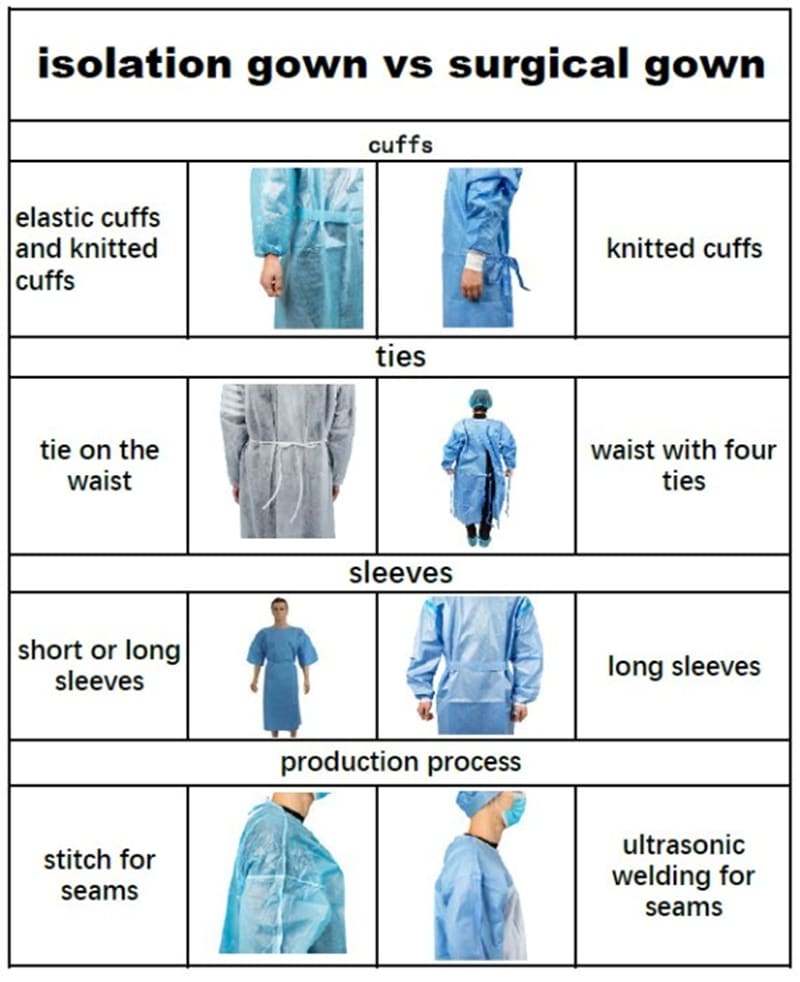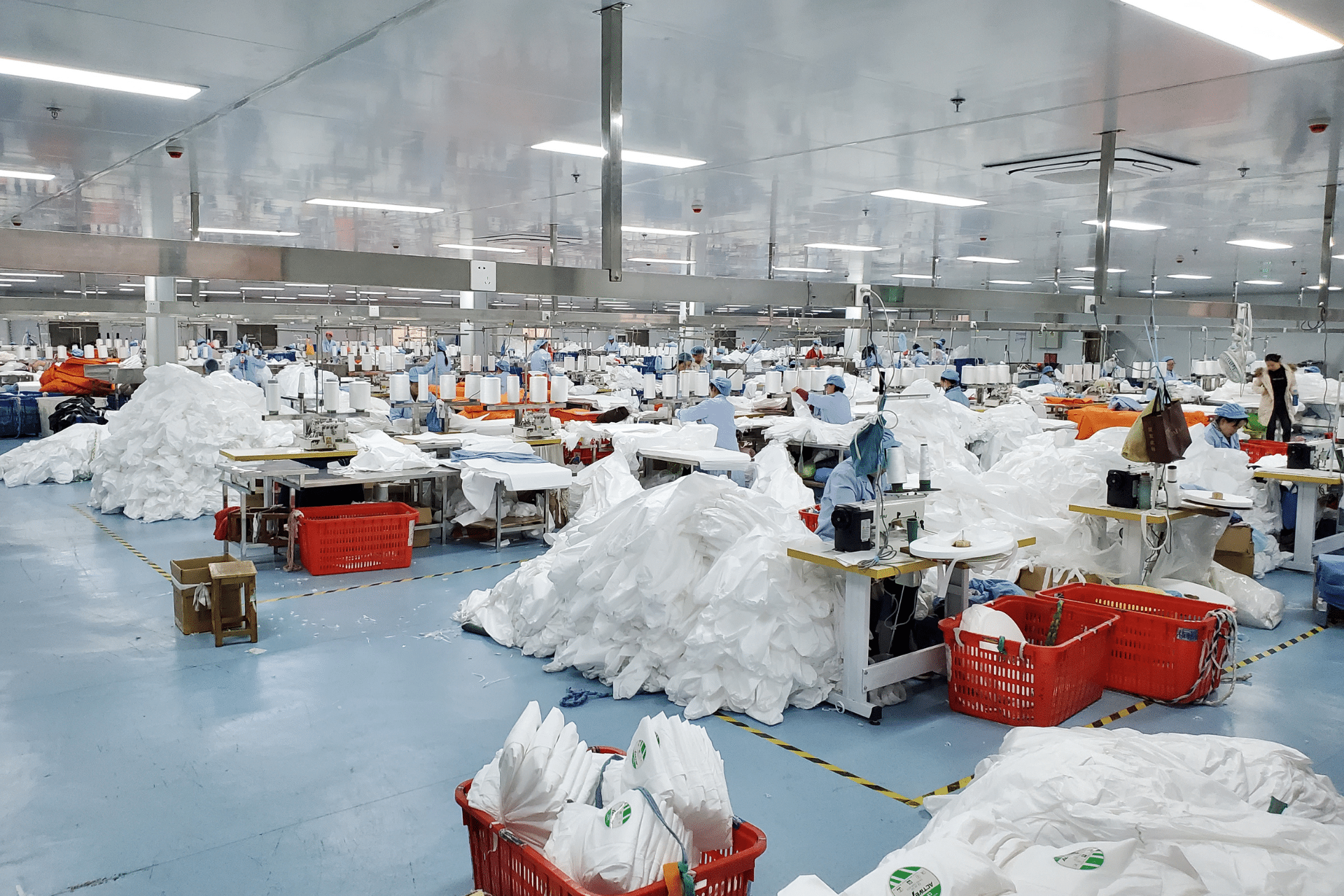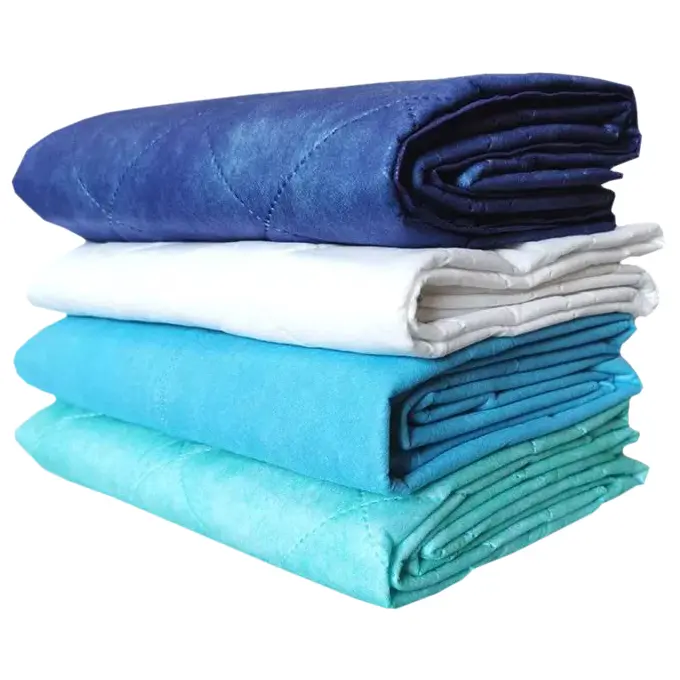Surgical gowns and isolation gowns are both personal protective equipment, They act as a liquid barrier protection against blood, bodily fluids, and other infectious materials, but there are some key differences between the surgical and isolation gowns. When purchasing surgical or isolation gowns? How to choose the right surgical or isolation gowns? In this blog post, we will discuss the differences between surgical gowns and isolation gowns.
What is Isolation gown
As personal protective equipment, Isolation gowns are designed to protect the wearer from the spread of infection or illness. The gowns serve two purposes: to protect healthcare workers from potential contaminants and to prevent healthcare workers from transferring microorganisms that could harm vulnerable patients. A isolation gown is a standard form of protective clothing worn by medical professionals, patients, and visitors.
Gowns act as a barrier, preventing direct contact with the patient and reducing the risk of bacterial or fluid exposure .They are typically made of disposable materials, such as non-woven fabric, and are worn in situations where there is a risk of contamination,such as emergency room. Isolation gowns are typically less protective than surgical gowns and are used in a variety of settings, including hospitals, clinics, emergency room and nursing homes.
What is surgical gown
Surgical gown is a personal protective equipment intended to be worn by health care personnel during surgical procedures to protect both the patient and health care personnel from the transfer of microorganisms,blood and body fluids, infectious diseases and particulate matter. Doctors wear gowns intended to prevent infection. They are made of a higher-quality, more durable material that is designed to withstand the rigors of a surgical setting. Surgical isolation gowns are typically worn during invasive procedures and provide a barrier between the surgical site and the medical professional’s clothing. Sometimes health care workers will wear other protective apparel
Difference of materials
Due to the different environments in which they are used, the material requirements for isolation gown and surgical gown are also different.
The material of Isolation gowns
Isolation gown is typically made of a lightweight, breathable material that allows the wearer to stay comfortable. They are made of PP, PP+PE, or SMS materials.
pp
PP is a lightweight and breathable material that allows the wearer to stay comfortable. It is also resistant to tears and rips.
PP+PE
PP+PE is a strong and durable material that can provide better protection against contaminants. It is also resistant to tears and rips.
ショートメール
SMS is a lightweight and breathable material that allows the wearer to stay comfortable.It is also resistant to tears and rips.It has good fluid intense procedures as the operating room gowns.
The material of Surgical gowns
Disposable surgical gowns are mainly made of disposable materials, mainly SMS,SMMS,SMMMS, and the reinforced sheets are non-woven composite materials, which can prevent the invasion of viruses and bacteria, and have good comfort performance and adsorption performance. The critical zones of protection include those areas where direct contact with blood, body fluids, and other potentially infectious materials, although areas outside of the critical zones can inadvertently be sprayed or splashed as well. Critical Protection Zones for Surgical Gowns The entire front of the gown, including the seam and other components, is required to have a barrier performance of at least level 1.
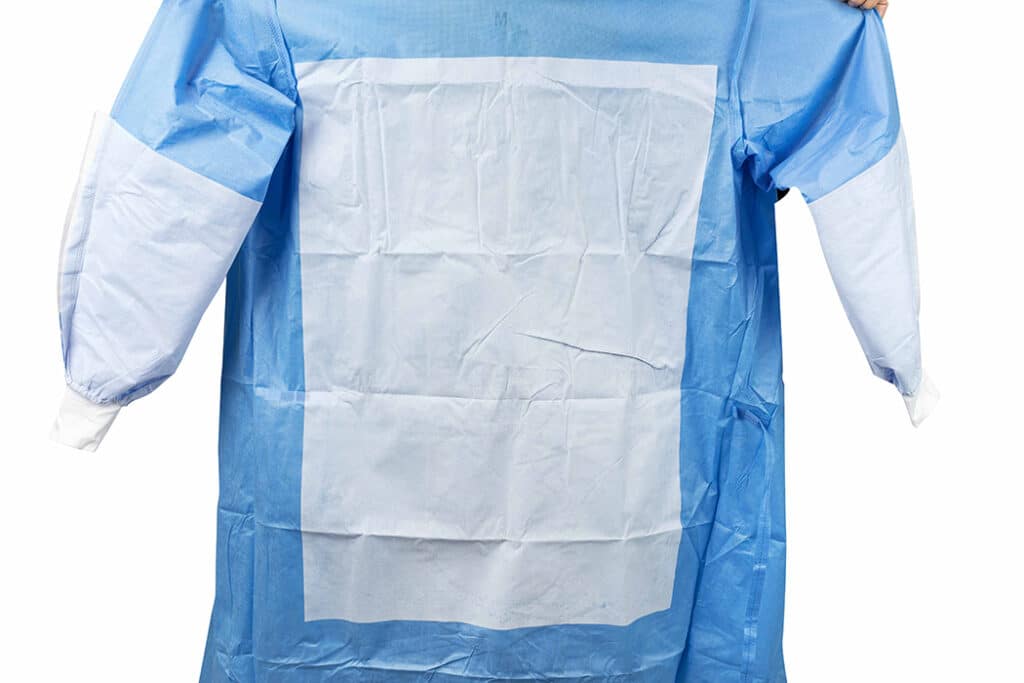
ショートメール
SMS non-woven fabric is made of spunbond non-woven fabric + meltblown non-woven fabric + spunbond non-woven fabric three-layer fiber web hot-rolled, which is a composite non-woven fabric, and it is a composite product of spunbond and meltblown. It is non-toxic, odorless and highly effective in isolating bacteria. Through special treatment of equipment, it can achieve the performance of anti-static, anti-alcohol, anti-plasma, water rejection and water production.
SMMS
Triple anti-spunbond nonwoven SMMS is made of spunbond nonwoven + meltblown nonwoven + meltblown nonwoven + spunbond nonwoven with four layers of fiber webs hot rolled. It has all the characteristics of ordinary SMMS nonwoven fabric; And it has higher liquid barrier performance .alcohol resistance up to 10 levels (i.e. 100% alcohol resistance); anti-static ability up to 108-1012; oil-proof; plasma-proof;
SMMMS
SMMMS can replace pure cotton fabric fabric, soft, delicate, and has excellent skin-friendliness. The spunbond layer consists of a continuous filament, with good breaking strength and elongation. It has the highest liquid barrier performance.The meltblown layer consists of continuous ultra-fine fibers, which have a good barrier effect on moisture, bacteria, and dust. It has high water pressure resistance and good air permeability, good acid and alkali resistance. Applicable to a variety of sterilization methods such as high and low temperatures.
The difference of styles between isolation gown and surgical gown
The style of a surgical gown and an isolation gown can vary depending on the specific design and manufacturer. In general, there are some key differences between the types of surgical isolation gown in terms of their style and design. Surgical gowns and isolation gowns have many differences in style, and they play different roles.
隔離ガウン
- Isolation gown’s sleeves vary according to the environment in which it is used, It is generally determined by the season. In summer, medical staff usually wear short-sleeved isolation gowns.
- Neck with velcro, sometimes it can also be with ties on the neck as requested.
- Waist with only one tie.
- The seams are usually stitched.
- The cuffs of the isolation gown can be knitted or elastic cuffs.
Surgical gown
Surgical gowns are worn as a barrier to fluid and microbial transmission during surgery. Usually, the styles are:
- Surgical gowns usually have long sleeves.
- Neck with velcro, sometimes it can also be with ties on the neck as requested.
- Waist with four wide ties.
- All seam parts are ultrasonic welding for better protection.
- The front chest and arm sleeves can be reinforced with PP+PE material for additional protection.
Differences in packaging
Because of the different scenarios and uses of isolation gowns and surgical gowns, they are packaged differently.
The packaging of the isolation gown
Isolation gowns are usually packed in 5 or 10 pieces into PE bags and are packaged in such a way that the air inside is extracted to form a vacuum. Such packaging has many advantages, waterproof, dustproof, and space-saving, conducive to transportation and preservation.
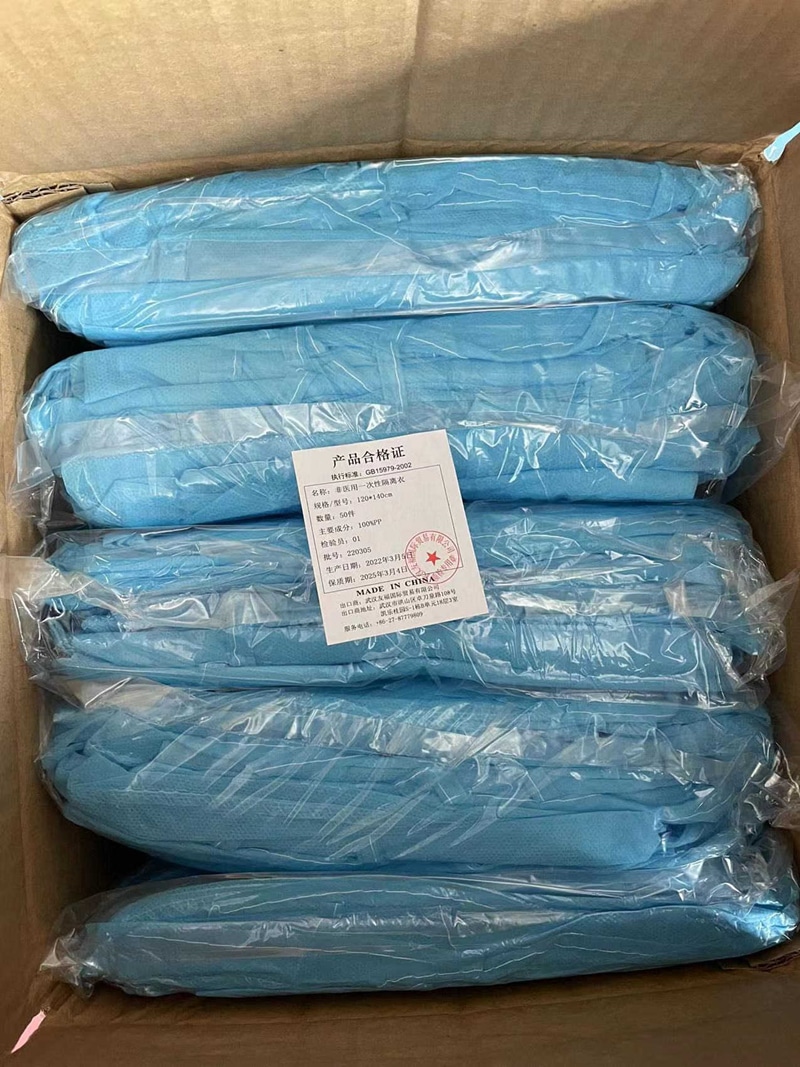
The packaging of the surgical gown
Due to the special nature of the surgical gown use scenario, in ICU, operating rooms, and other medical places that require strict control of the microbiological environment need to enter sterile things, without triggering other bacterial-type infections in patients, so the surgical gown packaging is usually a separate sterile package.
Surgical gowns are usually packaged in paper poly bags. This type of bag has paper on one side, which can be printed with product information, Or it can be labeled as a product and plastic on the other side. Usually, each surgical gown comes with a hand towel, which is sometimes packaged directly with the gown, or it can be wrapped in SMS wrapping cloth and placed in the bag.
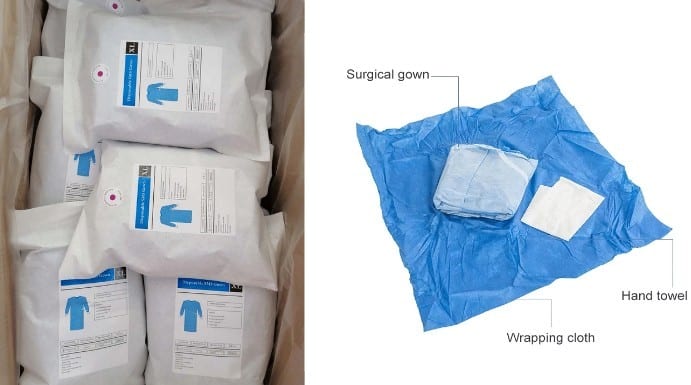
Differences in color
Since isolation gowns and surgical gowns are used in different scenarios and for different purposes, they have different colors, especially surgical gowns.
Why the surgical gown is blue?
Usually the surgical gown is in blue color. The main reason is that the body’s internal organs and blood are red, blue color is just complementary color to red. From a professional point of view, blue makes the most sense as a contrasting color to red, as it makes it easier for the doctor’s nervous brain to relax and regain its ability to recognize red.
The colors of isolation gown
Isolation gowns are available in a variety of colors, usually blue, yellow, or other colors. Of course, there is something to be said for these colors. In laboratories or hospitals, the color of isolation gowns is usually blue. In obstetrics and gynecology or pediatrics, the color of the isolation gown is pink, because pink is more friendly and reassuring to patients or children. Almost all mandatory protective clothing worn in medical facilities is usually yellow because it is the color that attracts the most attention, is hard to miss even from a distance, and indicates possible contamination in sensitive hospital areas.
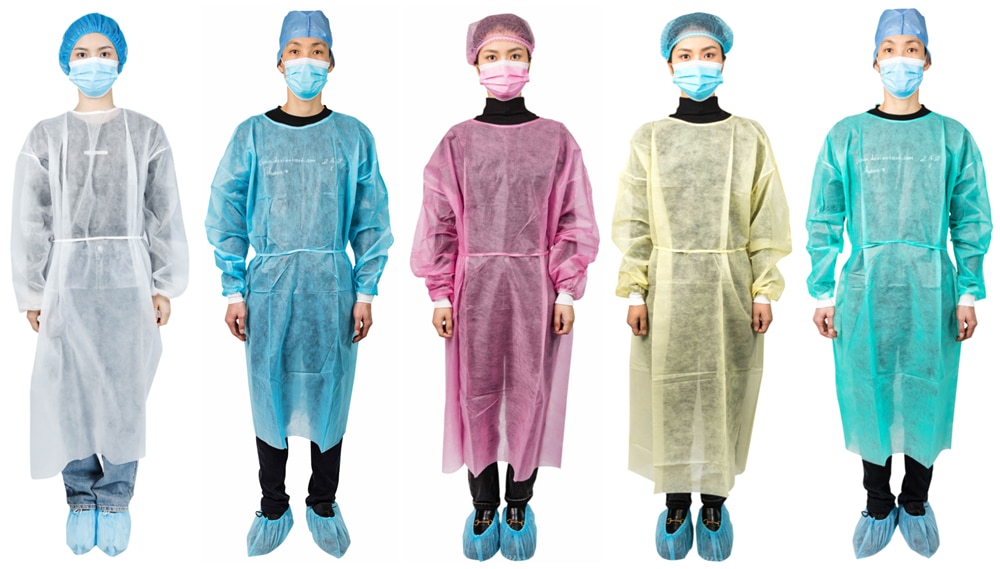
Quality standards of surgical gown and isolation gown
The level of protection provided by surgical gowns varies depending on the specific type of gown. In general, surgical gowns are classified into three levels of protection
- Level 1 s provide low-level protection and are typically made of lightweight, breathable materials. They are suitable for use in low risk procedures, such as administering injections or taking blood samples.A level 1 isolation gown is designed to be used for basic care, such as by those working in hospice, care homes, or low risk wards.
- Level 2 provide moderate-level protection and are typically made of a blend of polypropylene and polyethylene. They are suitable for use in procedures that have a moderate risk of contamination, such as inserting a catheter or performing a biopsy.
- Level 3 provides high-level protection and are typically made of a fluid-resistant, breathable material. They are suitable for use in procedures that have a high risk of contamination, such as performing open-heart surgery or delivering a baby by cesarean section.
There is also a difference in the manufacturing process between the two. Surgical gowns mainly use ultrasonic heat lamination technology, while isolation gowns mainly use thread stitching.
Key features of isolation gown vs Surgical gown
Key features of isolation gowns include:
- Generally non-sterile
- Used in various clinical settings, including isolation rooms and during patient care activities
- Provides a barrier against the transmission of infectious agents
- Loose-fitting with long sleeves, a waist tie, and sometimes a neck tie
- Disposable, single-use design
Key features of surgical gowns include:
- Sterile, intended for use during surgery or other sterile procedures
- Offers a higher level of protection against fluid penetration
- Designed to maintain a sterile environment during surgery
- May be disposable or reusable, depending on the material and design
- More form-fitting than isolation gowns, with secure closures at the back, waist, and neck
- Some designs feature additional reinforcement in critical areas, such as the chest and sleeves, for added protection
In summary, isolation gowns are primarily used to protect against the spread of infection in various healthcare settings, while surgical gowns are designed for use during sterile surgical procedures to maintain a sterile environment and protect both patients and healthcare workers. It is important to understand the difference between surgical gowns and isolation gowns, which can help you improve your understanding of both products and also help you pick a more appropriate product.

